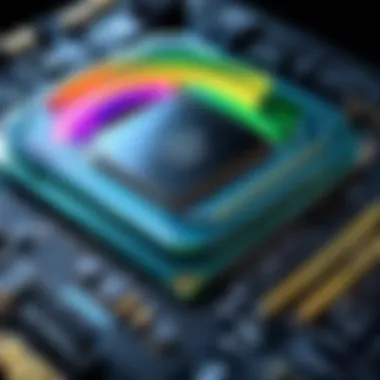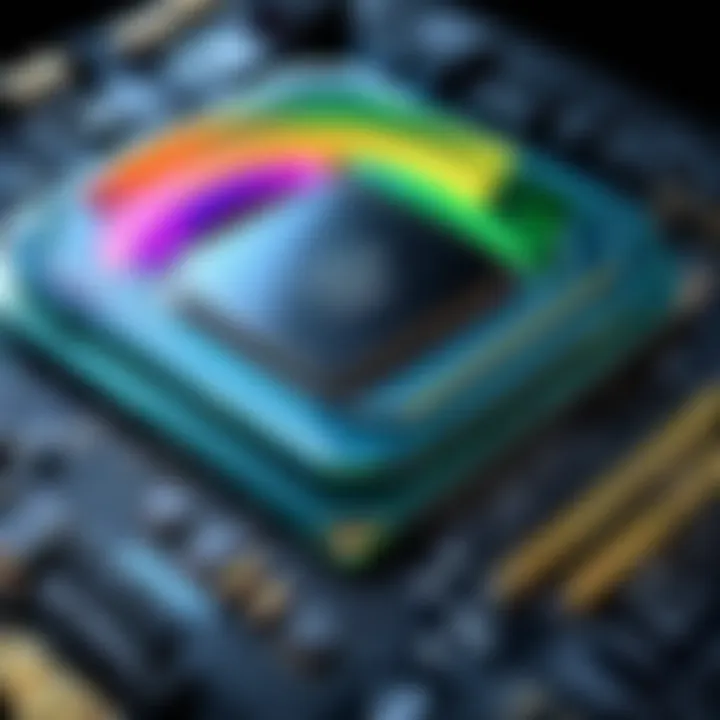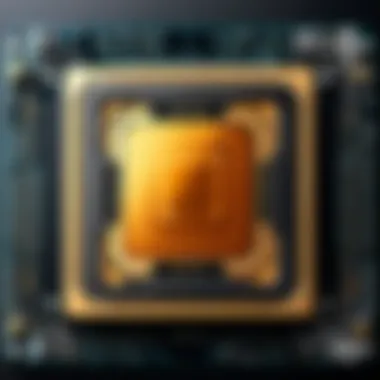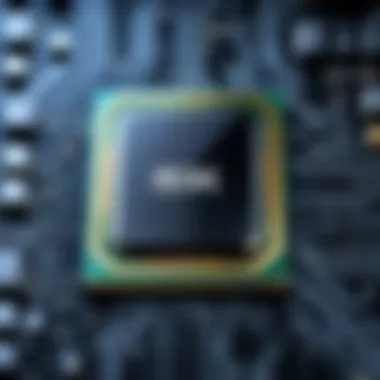Best Budget CPUs for Gaming in 2023: Expert Guide


Intro
In the realm of gaming, selecting the right CPU can significantly influence performance and overall experience. For gamers on a budget, this decision becomes even more critical. The current market is flooded with options that cater to various needs and preferences. As technology evolves, new contenders emerge, often providing impressive capabilities at a fraction of the cost associated with high-end models.
This guide focuses on optimal budget CPUs, unpacking their features, performance metrics, and compatibility considerations essential for budget-conscious gamers. With a careful analysis of these selected processors, readers will find a clearer path through the often confusing array of specifications and jargon.
Understanding the significance of value for performance can be the key to unlocking a satisfying gaming experience without draining financial resources. We will delve into which CPUs stand out in 2023, supported by benchmark results and real-world usage scenarios that showcase their strengths and weaknesses.
Let’s begin with an overview of standout products in this segment.
Understanding Budget Gaming
Understanding budget gaming is crucial for anyone looking to enjoy video games without spending excessively. In today's landscape, gaming can become a costly venture when factoring in hardware, software, and peripheral devices. With this in mind, discovering optimal budget CPUs can significantly enhance the gaming experience without leading to financial strain.
Budget gaming signifies a strategic approach to selecting equipment that delivers an adequate performance level relative to its price. It encourages gamers to make informed choices, balancing quality and affordability. Thus, understanding the essentials of budget gaming will provide clarity on how to optimize one's hardware choices, ultimately improving gameplay and satisfaction.
Defining Budget Gaming
Budget gaming is generally characterized by a focus on products that offer decent performance with limited spending. This often means selecting entry-level or mid-range components that can perform well for most gaming needs. The definition may vary depending on personal thresholds of affordability, but fundamentally, budget gaming seeks to maximize value, ensuring that gamers do not overspend on high-end equipment that may exceed their actual needs.
Key Considerations for Choosing a CPU
Choosing a CPU for budget gaming involves several critical factors that can influence overall system performance. Each aspect plays a significant role in achieving a balance between cost and efficiency.
Performance vs. Price
Performance versus price is perhaps the most critical consideration when selecting a CPU. Gamers need to consider how well a processor performs relative to its cost. Generally, the aim is to find a CPU that can handle the latest games without pushing the budget limits. High-performance CPUs, while appealing, often carry a hefty price tag that may not be justifiable for all gamers. Therefore, finding a processor that delivers a good performance at a competitive price is ideal. While it is tempting to opt for the cheapest option available, investing in a slightly higher-priced model may introduce notable performance improvements, especially in demanding gaming scenarios.
Future-proofing
Future-proofing is the concept of selecting a CPU that will remain relevant for an extended period. This involves anticipating the gaming landscape's continual evolution and selecting processors that can handle future generations of games. A CPU with more cores and higher clock speeds may offer significant advantages as game developers increasingly create titles that utilize multi-core processing. Investing in a CPU that is seen as future-proof can lead to longer-term value, saving expenditure on upgrades in the near future. The downside is that it may involve a higher initial investment compared to budget models that can quickly become outdated.
Compatibility with Other Components
Compatibility with other components is a crucial aspect of selecting a CPU. A gamer must ensure that the chosen CPU can work well with the motherboard, RAM, and power supply. Ignoring these aspects can result in performance bottlenecks or necessitate additional spending on compatible components. This consideration not only ensures system stability and performance but also facilitates smoother upgrades in the future. Ultimately, appreciable performance comes not just from the CPU alone but how well it interlinks with other hardware within the computer system.
Market Overview: Current Trends
Analyzing the current trends in CPU markets provides a contextual backdrop essential for making informed choices in budget gaming. This understanding helps to clarify the evolving state of technology and its implications on consumer decisions. As CPUs remain at the heart of gaming performance, the examination of market dynamics sheds light on the potential for value, performance, and innovation. The recent shifts in technology and pricing make it critical to stay informed on these trends.
Significant Advancements in CPU Technology
Multi-core Processing
Multi-core processing represents a key advancement in CPU technology, allowing for higher efficiency and enhanced multitasking capabilities. In gaming, using a CPU with multiple cores enables smoother gameplay by distributing workloads across processors. This improves the handling of complex game environments and high resource demands.
The primary characteristic of multi-core CPUs is their ability to manage several threads simultaneously. For gamers, this means better performance in titles designed to take advantage of multi-threading, resulting in improved frame rates and lower latency.
However, not all games utilize multiple cores effectively. While modern titles are increasingly optimized for multi-core systems, some older games may still perform better on higher clock speeds rather than more cores. Thus, it is crucial to consider the specific gaming needs before making a selection.
Integrated Graphics Capabilities
Integrated graphics capabilities offer a significant benefit for budget-conscious gamers. Many CPUs now include integrated GPUs, which allow users to run games without needing a dedicated graphics card. This integration can save considerable costs and space, especially for those new to gaming setups.
One notable feature of integrated graphics is their continual improvement in performance. Companies like AMD and Intel have made strides in enhancing graphics output, allowing many popular games to run at playable settings on lower budgets. While integrated graphics might not match the performance of high-end dedicated graphics cards, they still present an attractive option for casual gamers or those looking to build an affordable system.


Though convenient, it is essential to recognize the limitations. Integrated graphics typically cannot handle graphically intensive games on high settings. Gamers with ambitions to explore more demanding titles in the future may eventually need to invest in a dedicated GPU.
Price Fluctuations and Availability
Impact of Supply Chain Issues
Supply chain issues have had a profound impact on CPU prices and availability. Factors such as material shortages and shipping delays have led to significant fluctuations in pricing. This situation has forced consumers to adapt to rapidly changing market conditions.
The core characteristic of the current landscape is a lack of stability. Prices can vary dramatically from week to week, often without clear rationale behind these shifts. Those looking to buy must exercise caution and consider shopping around. Generally, awareness of potential delays and price increases can mean the difference between securing a good deal or overpaying for a product.
The advantage of understanding these issues lies in being prepared. When buyers know the market condition, they can time their purchases better, ensuring they acquire CPUs at optimal prices and availability.
Noteworthy Sales Trends
Noteworthy sales trends indicate how market demand is evolving and which products are gaining traction. Promotions and discounts periodically emerge, particularly around holidays, providing consumers with opportunities to acquire high-value components without exceeding budgets.
A key characteristic of these trends is the seasonal nature of sales. Major events, such as Black Friday or Cyber Monday, consistently lead to significant markdowns on CPUs. For budget gamers, these events are a prime opportunity to acquire performance-enhancing hardware
While sales trends offer potential savings, consumers must approach with caution. Newer models frequently emerge right after major promotions, which can lead to frustration if purchases are made just before the release of superior options. Monitoring trends can ensure that budget gamers make strategic decisions based on timing and potential for future upgrades.
"Staying updated on CPU trends is vital for budget gaming, allowing consumers to maximize both value and performance."
By delving into these market trends, gamers can better align their budgetary considerations with technological advancements and availability. Recognizing the interplay between supply, demand, and pricing dynamics ultimately paves the way for informed purchasing decisions that strategically benefit the gaming experience.
Evaluating Performance Metrics
Evaluating performance metrics is crucial for identifying the best budget CPUs for gaming. This section delves into the various factors that impact CPU performance, shedding light on essential metrics that influence gaming experiences. Understanding these metrics helps in making informed decisions when selecting a CPU, ensuring that the chosen model aligns with both expected performance and gaming requirements.
Understanding Clock Speed and Cores
Clock speed and core count are primary specifications to consider when evaluating CPU performance. Clock speed, measured in gigahertz (GHz), indicates how fast a CPU can execute instructions. Higher clock speeds often lead to better performance in tasks that these CPUs handle, particularly in gaming scenarios. However, clock speed alone does not define overall performance.
The number of cores in a CPU also plays a significant role. Modern games are developed to utilize multiple cores, allowing for better multitasking and performance during intense gaming sessions. A CPU with more cores can handle several tasks simultaneously, which is beneficial for gaming alongside background applications like streaming or voice chat. Therefore, both clock speed and core count need to be balanced to achieve optimal performance without overspending.
Benchmarking: How to Assess Performance
Benchmarking serves as a practical approach to measure CPU performance across various games and applications. This process highlights how different models perform under comparable conditions. There are two main areas of focus in benchmarking: single-thread and multi-thread performance. Understanding these distinctions is important for assessing which CPU will suit your gaming needs best.
Single-thread vs. Multi-thread Performance
Single-thread performance refers to the capability of a CPU to process tasks using only one core. This aspect is especially important for older games or applications that rely heavily on single-thread execution. High single-thread performance results in improved responsiveness and frame rates in such scenarios.
Conversely, multi-thread performance covers the CPU's ability to manage multiple tasks concurrently across several cores. Games that can leverage multiple threads benefit from enhanced gaming performance and smoother experiences. While both performance metrics are significant, understanding the requirements of specific games will assist gamers in making a more informed decision. Generally, CPUs excelling in both areas are rare but offer a more versatile solution for gamers.
Real-World Gaming Benchmarks
Real-world gaming benchmarks provide crucial insights into CPU performance in actual gaming scenarios. These benchmarks go beyond theoretical metrics and reflect how a CPU performs during gameplay. They are typically derived from tests conducted under various conditions, making them valuable for prospective buyers.
Real-world benchmarks help users gauge frame rates, loading times, and overall gameplay smoothness across different gaming titles. By comparing these metrics, one can ascertain which budget CPUs deliver the best gaming experiences. However, it's essential to consider the specific games being tested, as performance may vary significantly across different game genres and architectures. Evaluating these benchmarks can save time and resources while ensuring that your chosen CPU aligns well with intended gaming styles.
"In the realm of budget CPUs, performance metrics are key to understanding what to expect from your gaming experience. Prioritize both individual CPU characteristics and real-world applications."
In summary, evaluating performance metrics is an essential step when choosing a budget CPU for gaming. Clock speed, core count, and benchmarking results collectively inform users about the capabilities of various models. Armed with this knowledge, gamers can confidently choose CPUs that meet personal requirements without compromising on performance or value.
Top Budget CPUs for Gaming
In the world of gaming, the right CPU can significantly influence your gaming experience. Budget CPUs offer a balance between performance and cost, making them essential for gamers looking to upgrade without breaking the bank. This section will detail some of the best options, highlighting their key characteristics and benefits. Affordable does not necessarily mean low quality; it can also mean thoughtful features that cater to gaming needs.


AMD Ryzen Series
Overview of Popular Models
The AMD Ryzen series has gained a reputation for offering great performance at competitive prices. Key models in the Ryzen family include the Ryzen 3 3300X, Ryzen 5 5600G, and the Ryzen 7 5700G. These CPUs stand out due to their multi-core architecture, often providing better multitasking capabilities than comparable Intel options. Their integrated graphics make them a versatile choice for budget-conscious gamers. For example, the Ryzen 5 5600G uniquely combines reasonable price with solid gaming performance, allowing users to play many modern titles at decent settings without a dedicated GPU.
Pros and Cons of Each Model
When deliberating over the strengths and weaknesses of the AMD Ryzen series, each model has distinct advantages. The Ryzen 3 3300X has excellent single-thread performance but may lack in integrated graphics capabilities. The Ryzen 5 5600G, on the other hand, excels both in gaming and productivity tasks, making it a popular choice. A notable downside is that some older motherboards may not support the latest Ryzen models, necessitating a more dedicated search for compatible parts.
Intel Core Series
Analysis of Key Performers
The Intel Core series remains a prominent choice, with models like the Core i3-12100F and Core i5-12400 leading the way among budget options. One key characteristic of these CPUs is their capability of outperforming their AMD counterparts in certain gaming scenarios, particularly in single-threaded performance. The Core i5-12400 presents a balanced approach, offering solid gaming performance while being reasonably priced. However, limited integrated graphics options could be a drawback for users not planning to purchase a dedicated GPU.
Comparing Value to the AMD Alternatives
When comparing the Intel Core series and AMD Ryzen series, the choice often hinges on specific gaming needs and budgetary constraints. Intel CPUs, particularly the Core i3 and i5 models, may deliver higher frames per second in some titles. However, Ryzen's advantage in multitasking and integrated graphics brings a significant value benefit. Therefore, the decision largely depends on whether a gamer prioritizes raw performance or seeks a versatile all-in-one solution.
Emerging Contenders
Evaluating Lesser-Known Brands
While AMD and Intel dominate the market, several emerging brands are worth considering. Manufacturers like Microcenter’s PowerSpec and some models of ASRock CPUs have gained traction for their affordability without compromising performance. These brands often provide unique offerings that cater to niche markets, allowing budget gamers to explore cost-effective alternatives. While the performance may not always meet the standards set by larger companies, they can satisfy many users' basic gaming needs.
Performance and Value Analysis
Evaluating performance and value in lesser-known brands can yield pleasant surprises. Many of these CPUs offer competitive specifications at a much lower price point. For instance, a new brand may feature comparable core counts or clock speeds to more established brands. This can provide significant savings. However, potential buyers should proceed with caution, as long-term support and reliability can be a concern with these lesser-known products.
Compatibility Considerations
Understanding compatibility considerations is essential when selecting a CPU for budget gaming. These factors can significantly influence the performance, functionality, and longevity of a gaming setup. Proper compatibility ensures that all components in a build work together efficiently, preventing potential bottlenecks that may hinder gaming experiences.
Motherboard Selection
Chipset Compatibility
Chipset compatibility serves as a crucial aspect of a motherboard selection that directly impacts the capabilities of a CPU. Each CPU has a specific set of chipsets it can work with, typically outlined by the motherboard manufacturers. For example, AMD CPUs often pair well with B550 and X570 chipsets, while Intel's newer offerings are commonly compatible with Z490 and B460 chipsets.
A key characteristic of chipset compatibility is its role in determining support for various features like overclocking and PCIe lane distributions. Choosing a motherboard with the right chipset can enhance the CPU's performance and enable future upgrades.
The unique feature of knowing chipset compatibility lies in how it shapes the overall gaming experience. A motherboard that supports the latest chipset will provide optimal performance for modern games. Failing to match the CPU with the right chipset might limit graphical capabilities or overall speed. This can lead to an underwhelming gaming experience, which is not favorable for budget-conscious gamers.
Future Upgrade Paths
Future upgrade paths are a vital consideration in CPU selection. As technology progresses, gamers often seek to improve their systems over time. A motherboard with a well-established upgrade path allows for easy upgrades without requiring additional investments in components.
The key characteristic of a robust future upgrade path is flexibility. This means that a gamer can swap out CPUs for newer models in the same family without having to replace the entire motherboard. Such choices are crucial for individuals who want to future-proof their gaming builds, allowing them to take advantage of technological advancements without overstretching their budget.
A unique feature of a quality motherboard is the presence of multiple expansion slots and the support for subsequent generations of CPUs. However, choosing a motherboard with limited upgrade options may lead to frustration down the line, as it would require more significant investments to fully realize performance improvements.
Cooling Solutions
Air Coolers vs. Liquid Coolers
In the realm of CPU cooling, the choice between air coolers and liquid coolers is prevalent. Each type has its strengths and weaknesses, impacting overall system performance and maintenance. Air coolers are generally easier to install and require less maintenance compared to liquid cooling systems.


A key characteristic of air coolers is their straightforward design. They use metal heat sinks and fans to dissipate heat, making them a popular choice for budget builds. Their reliability is a significant advantage, as they rarely fail compared to liquid counterparts, which can experience pump failures or leaks.
On the other hand, liquid coolers offer superior cooling performance and quieter operation. However, they can be more expensive and involve intricate setups. Understanding the pros and cons of each type can determine the best cooling solution for a specific gaming need.
Size and Clearance Considerations
Size and clearance considerations are impactful when selecting both CPUs and motherboards. Not all CPU coolers fit into every case, and measurements such as height and width become important when planning a build.Units that do not fit can lead not only to aesthetic issues but also to practical ones, like airflow restrictions affecting cooling performance.
A notable characteristic of paying attention to size and clearance is ensuring effective airflow within the case. Good airflow is critical for preventing overheating, particularly in budget builds where component quality may vary. A wise choice in cooler size ensures the system remains operational during demanding gaming sessions.
The unique feature here is the availability of compact coolers designed for smaller setups. While compact coolers often sacrifice some cooling efficiency, they can fit snugly within cases where larger coolers cannot. Hence, carefully weighing size against thermal performance is necessary for an optimal budget gaming setup.
Cost-Effectiveness Analysis
Cost-effectiveness is a crucial aspect when selecting a CPU for budget gaming. It provides insights into how well a CPU performs relative to its price. Gamers on a budget need to ensure that their chosen components deliver the best value without sacrificing performance. Furthermore, understanding the cost-effectiveness of a CPU can help buyers make informed decisions that align with their gaming needs and financial constraints.
Total Cost of Ownership
Long-term Value Retention
Long-term value retention refers to how well a CPU maintains its worth over time. A CPU that retains value is an attractive option for gamers who might consider upgrading in the future. This characteristic indicates durability and continued relevance within the market. One unique feature of long-term value retention is the ability to deliver solid performance across multiple gaming titles for many years.
Choosing a CPU recognized for its long-term value retention encourages gamers to invest thoughtfully. A processor that still performs well even after several performance upgrades in the gaming ecosystem can be a wise choice. This advantage makes gamers less likely to experience buyer's remorse, especially if they do not plan frequent upgrades.
Reputation of Manufacturer
The reputation of a manufacturer plays a vital role in the CPU selection process. Established brands like AMD and Intel provide reliable products. Their long-standing presence in the market often correlates with customer trust and perceived product quality. This aspect is essential for ensuring satisfaction with a purchase.
Consumers tend to favor CPUs from reputable manufacturers since they come with warranties and after-sale support. A key characteristic of a strong manufacturer reputation is a history of consistent performance. As a result, buyers can expect better customer service and responsiveness to potential issues. However, lesser-known brands might offer compelling prices, but their lack of established credibility can deter buyers. Evaluating manufacturer reputation can significantly inform a well-rounded purchasing strategy.
Used vs. New CPUs
The decision to choose between used and new CPUs presents various factors to contemplate. New CPUs often feature the latest technology and performance enhancements. They have full manufacturer warranties, which can assure buyers of their quality and reliability. However, new models typically come at a higher price.
On the other hand, used CPUs provide a more budget-friendly alternative, allowing gamers to access high-performing hardware at a reduced cost. Buyers can often find models that, while not the latest, still perform exceptionally well in gaming scenarios. However, this route comes with risks such as lack of warranty and potential hidden issues.
Choosing between used and new CPUs ultimately depends on individual circumstances and risk tolerance. The preference for one over the other highlights what a consumer values more: immediate performance and warranty or value savings with possible uncertainty.
Long-Term Considerations
In the world of budget gaming, long-term considerations play a crucial role in ensuring that your investment remains valuable over time. Gaming is not just about performance in the moment; it is about understanding how your CPU choice impacts usability years down the line. Choosing the right CPU can help prevent premature upgrades and retain relevance as software demands evolve. Key aspects such as lifespan evaluation and upgrade pathways reveal why these considerations should not be overlooked.
Evaluating Lifespan of CPUs
The lifespan of a CPU is determined by various factors, including its architecture, thermal efficiency, and how well it handles future gaming titles. Most modern CPUs can operate efficiently for several years, but certain models stand out more than others in terms of longevity.
When evaluating CPU lifespan, it is essential to consider:
- Thermal Design Power (TDP): Components that run cooler tend to have longer lifespans due to less thermal stress.
- Manufacturing Process: CPUs built on a smaller process node (e.g., 7nm vs. 14nm) are generally more energy-efficient and produce less heat.
- Performance Benchmarks: CPUs that maintain competitive performance in games as they are released will extend usability.
An example would be AMD's Ryzen 5 series, which offers good TDP ratings and strong performance metrics. This can result in a lifespan that allows users to enjoy a satisfying gaming experience beyond typical upgrade cycles.
Upgrade Options and Pathways
Planning for future upgrades is essential for maintaining an effective budget gaming setup. Understanding which CPUs can be upgraded without significant overhaul saves both time and money. Not all motherboards support newer CPU generations, hence compatibility is key.
Major upgrade pathways to consider include:
- Socket Compatibility: Choose CPUs and motherboards that share the same socket to enable future upgrades.
- BIOS Support: Some motherboards may require a BIOS update to support newer CPUs. It is critical to confirm this ahead of time.
- Multi-core Scaling: CPUs with more cores and threads generally offer better performance headroom for future games that utilize these capabilities.
Tip: Investing in high-performance cooling solutions can allow even budget CPUs to be overclocked, thus extending their functional lifespan and making them more adaptable to future requirements.
In essence, addressing long-term considerations like lifespan evaluation and upgrade pathways positions budget-conscious gamers to achieve more from their hardware without frequent, costly transitions. Understanding these factors will lead to better decision-making when investing in your gaming rig's central processing unit.



